Published Date : 09 October 2025
Posted by : Ipseeta Dash
In a world defined by growing populations, rapid urbanization, and increasing consumption, the world is facing a mounting waste crisis. Every day, millions of tons of municipal solid waste are thrown into landfills or left to pollute the environment. As traditional waste disposal methods seem to be unsustainable, Waste-to-Energy (WTE) technologies are emerging as a strong mechanism to transform waste into clean, usable energy, effectively turning trash into treasure.
What is Waste-to-Energy (WTE)?
Waste-to-Energy refers to a collection of technologies that convert non-recyclable waste materials into usable forms of energy, such as electricity, heat, or fuel. These technologies offer a dual benefit, i.e., waste reduction and power recovery. The key motto of WTE is simple: rather than letting waste stay stagnant in landfills and release harmful greenhouse gases, why not treat it as a resource? Through processes such as incineration, gasification, pyrolysis, and anaerobic digestion, WTE systems use the latent energy stored in organic and non-recyclable materials.
The Growing Need for WTE Solutions
Global waste production is projected to reach 3.4 billion tons by 2050, up from 2.01 billion tons in 2016, according to the World Bank. At the same time, more than 1.6 billion tons of CO₂-equivalent greenhouse gases are emitted annually from poorly managed landfills. According to the same report, the daily per capita waste generation in high-income countries is expected to rise by almost 19 percent by 2050, compared to low- and middle-income countries, where it is expected to increase by approximately 38% or more.

source: World Bank
Global WTE Landscape
Many countries have increasingly implemented waste-to-energy on a larger scale. Given below are a few examples of the same.
|
Country |
WTE Highlights |
|
Sweden |
- Converts ~99% of waste into energy or recycling - Operates 30+ incineration plants- Imports waste from neighboring countries for energy production |
|
Japan |
- Leader in urban waste management- Advanced WTE incineration technology, especially in Tokyo - Daily waste processing powers electricity generation, reducing landfill use |
|
Germany |
- Enforces strict landfill bans - Processes >60% of waste via incineration and anaerobic digestion - Integrates WTE output into national power grid |
|
India |
- Generates 62+ million tons of waste annually - Limited waste refinement capacity - Government initiatives like Swachh Bharat and Smart Cities support WTE adoption for urban waste solutions |
Advantages of Waste-to-Energy
The adoption of WTE systems offers innumerable benefits. As countries struggle with challenges in managing rising waste and changing to sustainable energy sources, WTE marks a promising, multifaceted solution. Here are the primary benefits WTE uses in modern waste management systems:
- Minimizes Landfill Waste: One of the most important advantages of Waste-to-Energy systems is the reduction in landfill dependency. In general, traditional landfills are not only space-consuming but also prime contributors to high environmental pollution, including groundwater contamination and methane emissions. WTE technologies can reduce the amount of waste up to 90%, significantly lowering the pressure on landfills. By diverting waste from these sites, municipalities can conserve valuable spaces, extend landfill lifespan, and minimize the long-term environmental liabilities related to waste deposition. This is mainly important in urban areas where land is scarce and expensive.
- Generates Clean Energy: Waste-to-Energy plays an important role in expanding the world’s renewable and alternative energy portfolio. By converting non-recyclable waste into electricity, heat, or fuel, WTE systems change environmental burdens into valuable energy resources. These energy outputs can be used to power homes, industries, and public infrastructure, reducing reliance on fossil fuels. Modern WTE plants are equipped with high-efficiency turbines and emission control systems that make them capable of producing clean, consistent, and base-load energy, something that solar and wind power, which are intermittent by nature, may not always provide. In this way, WTE helps balance and diversify the energy generated.
- Reduces Greenhouse Gas Emissions: Landfills are high emitters of methane, a greenhouse gas that is over 25 times stronger than carbon dioxide. By preventing waste from being dumped in landfills, WTE systems avoid the unmanaged release of methane and other landfill gases. Additionally, by producing electricity and heat from waste, these systems balance the need for fossil fuel-based power generation, further contributing to climate change reduction. Studies have indicated that WTE solutions can lead to net reductions in greenhouse gas, especially when combined with recycling and composting in a wider waste management strategy.
- Supports the Circular Economy: Waste-to-Energy technologies are an important component of the circular economy model, where the aim is to keep materials and energy in use for as long as possible. In a traditional linear economy, products are made, used, and then discarded. WTE disturbs this pattern by ensuring that even non-recyclable and residual waste materials can serve a productive role after their initial life cycle. The energy recovered from waste can be redirected back into the economy, while the by-products, such as ash and digestate, can be repurposed in construction or agriculture.
- Creates Job Opportunities and Innovation: WTE infrastructure helps domestic economies by creating skilled, trained, and semi-skilled employment opportunities in plant construction, operations, maintenance, and logistics. Moreover, as nations and cities strive to meet sustainability goals, WTE encourages the upgradation of next-generation technologies, such as advanced gasification, pyrolysis, and carbon capture systems. This promotes economic development while handling environmental challenges, making WTE a win-win solution for both people and the planet.
Future Trends in Waste-to-Energy
As the global demand for sustainable waste management and renewable energy continues to rise, the WTE sector is undergoing a significant transformation. Technological advancements, supportive policy surroundings, and increased environmental awareness are driving innovation and reshaping how waste is converted into energy. The following emerging trends highlight the track in which WTE is evolving:
- Integration with Smart Grids: One of the most promising developments in the WTE landscape is the integration of WTE facilities with smart grids. Smart grids employ digital technology to predict, monitor, and optimize the production and distribution of electricity in real time. By linking WTE plants to smart grid systems, operators can manage energy output efficiently based on demand fluctuations, assuring a more stable and reliable power supply. This not only improves grid resilience but also enables better utilization of energy generated from waste. Furthermore, integration with smart grids promotes the shift to decentralized, low-carbon energy systems, where waste-derived power can complement other renewable sources.
- Carbon Capture and Storage (CCS): As environmental regulations become more stringent and the urgency to address climate change intensifies, CCS is gaining attention in the WTE sector. WTE plants, particularly those using incineration or gasification, release carbon dioxide during the decomposition process. Merging CCS technologies enables facilities to trap and store CO₂ emissions before they release into the atmosphere. This captured carbon can be stored underground and used in industrial processes in producing synthetic fuels or building materials. This fusion of CCS in WTE marks an important step in achieving zero carbon emissions.
- Decentralized WTE Systems: Traditional WTE infrastructure is likely large-scale and centralized, typically located near urban centers. However, there is a rising trend toward decentralized, modular WTE units that can be used in smaller communities, industrial parks, or off-grid locations. These compact systems are built to handle local waste, reducing the need for long-distance transportation and allowing for on-site energy generation. This approach not only reduces logistical and environmental costs but also supports rural and remote regions to manage their waste independently while giving access to reliable energy.
- Hybrid Energy Models: To increase efficiency and sustainability, future energy systems are exploring hybrid models that combine multiple renewable energy sources. In this context, WTE is being fused with solar, wind, and battery storage technologies to create multi-source energy hubs. For instance, WTE plants can offer base-load power constantly, while solar and wind provide additional electricity during peak periods. Battery storage systems then balance supply and demand by storing excess energy to be used later. These hybrid models improve energy security, grid stability, and performance.
These future trends highlight a huge transformation toward smarter, cleaner, and more equitable energy systems. Waste-to-Energy, once viewed as a transitional technology, is now set to become the foundation of circular and sustainable economies. As innovation continues, WTE will not only manage our waste more effectively but also power our future more responsibly.
The saying one man’s trash is another man’s treasure has never been truer. Waste-to-Energy is not just a technology; it’s a transformative mindset. It allows us to handle the twin crises of energy scarcity and environmental degradation in one powerful sweep. As technology enhances with supportive governmental policies, WTE will play an important role in creating sustainable cities, strong energy systems, and a greener planet.
Contact Us







